You’re probably familiar with the Tomb Raider movie starring the stunning and charismatic Angelina Jolie. The film not only showcased the beauty of its lead actress but also the mystical charm of the Angkor region in Siem Reap, Cambodia. Although the actual setting was Ta Prohm Temple, Angelina Jolie, through her role as Lara Croft, brought global attention to the site, attracting millions of foreign tourists to Angkor Wat.
I was reminded of this movie when I read news about a sequel being made, featuring another equally captivating actress. It also brought back memories of my trip to Siem Reap, where my main goal was to explore the Angkor complex. Like many others, I was drawn there partly because of Tomb Raider.
To get to Siem Reap, you can take direct flights from Kuala Lumpur or Singapore, but the tickets are expensive. After researching travel options, I found the most budget-friendly way, flying from Singapore to Bangkok, Thailand, and then taking a bus to Siem Reap. There’s a direct bus service, so you don’t need to switch buses at the border, which can be costly.
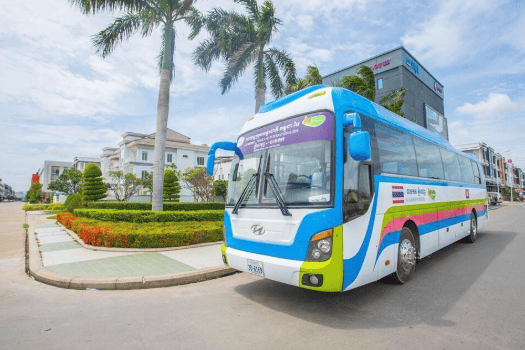
In Bangkok, there’s a bus service called Nattakan. Tickets for Nattakan buses can be purchased at the Northern Bus Terminal, also known as Mo Chit 2 Bus Terminal or Chatuchak Bus Terminal. Look for The Transport Co., Ltd. counter. A ticket from Bangkok to Siem Reap costs $28 USD and can now also be bought online. The bus departs at 8:00 AM and 9:00 AM, but I arranged to take the 9:00 AM bus with a Dutch backpacker I met in Bangkok—neither of us are early risers! Onboard, we met two other backpackers, one from Indonesia and another from the Netherlands, forming a group of four. The journey was long, as we had to stop at the border where passport checks were time-consuming. We finally arrived at our accommodation in Siem Reap around 8:00 PM.
The next day, we explored the Angkor Wat complex, renting a tuk-tuk for the four of us. We set off at 5:00 AM to catch the sunrise at Angkor Wat. A one-day ticket costs $20 USD per person, although it has since increased to $37 USD. A three-day pass is $62 USD, and a seven-day pass is $72 USD. At the entrance, our photos were taken and printed directly onto our tickets.
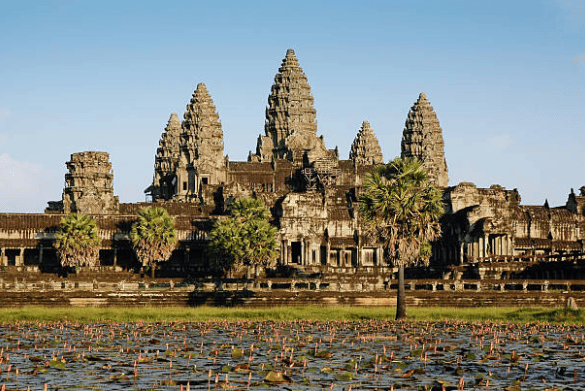
Even in the dark, the Angkor complex was bustling with visitors. The first temple you encounter is Angkor Wat, the main and best-preserved temple. Its entrance is flanked by small lakes, which are actually part of a surrounding moat. Here, we joined hundreds, possibly thousands, of tourists waiting for the sunrise. When the golden sun finally emerged, its reflection shimmering in the water, it was a breathtaking sight.
The sunrise wasn’t the only highlight. Exploring the inner sections of Angkor Wat was equally fascinating. By mid-morning, we began touring the rest of the Angkor complex. Angkor Wat, with its distinctive Khmer architecture, is remarkably well-preserved. Its walls are adorned with intricate reliefs depicting royal stories and the founding of Angkor.
From Angkor Wat, we visited a selection of must-see temples within the complex. We only had one day, which is far from enough to cover the entirety of the 400-square-kilometer site. This ancient city, designated a UNESCO World Heritage Site, contains thousands of temples and shrines, making it a true marvel of history and culture.
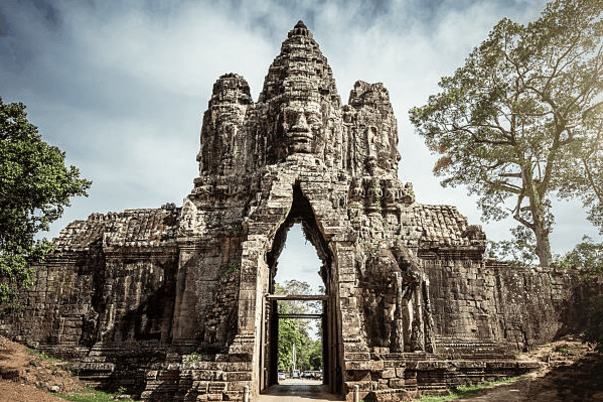
The sound of the tuk-tuk engine broke the silence of the road we were traveling. The lush green forest stretched around us, with ancient temples adorning the area. On our way to the next temple, we passed through the South Gate, one of the four entrances used in ancient times to access Angkor. Back then, Angkor was surrounded by a square fortress that protected the Khmer Empire. The South Gate’s pinnacle resembles that of Prambanan Temple, but its façade features carved faces.
This well-preserved gate lies along the route from Angkor Wat to Bayon Temple. Although Bayon is not entirely intact, it is considered the most artistic and beautiful, boasting intricate and detailed reliefs. Bayon Temple is home to 216 colossal stone faces, believed to depict the likeness of King Jayavarman VII, the founder of the Khmer Empire and Angkor. We explored Bayon, climbing one of its sections to admire its stunning architecture.
Not far from Bayon is Baphuon Temple, reachable on foot. Visitors enter from the side of the temple, where a 200-meter-long elevated pathway, about one meter above the ground, leads to the main structure, giving the impression of a small bridge. Baphuon consists of three levels, and visitors can climb to the top. However, the stairs are steep, so those afraid of heights may want to avoid the climb.
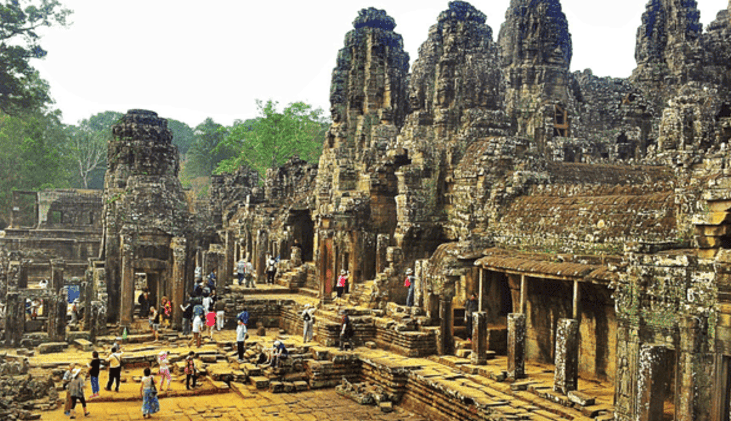
The scorching sun soon drove us down from Baphuon. We sought shade under the surrounding trees, marveling at the temple’s beauty from afar. Once we cooled off, we headed to the Terrace of Elephants. As the name suggests, this 350-meter-long terrace features carvings of elephants and their trunks. Elephants played a vital role in the past and are still used today to give tourists rides around Angkor. The Terrace of Elephants was historically a platform where King Jayavarman VIII welcomed and reviewed his troops returning from battle.
Among the many temples in Angkor, Ta Prohm is a must-visit. As mentioned earlier, this temple served as a filming location for Tomb Raider. Giant trees and their sprawling roots envelop Ta Prohm, enhancing its mystical atmosphere. Parts of the temple have collapsed, adding to its enigmatic allure.
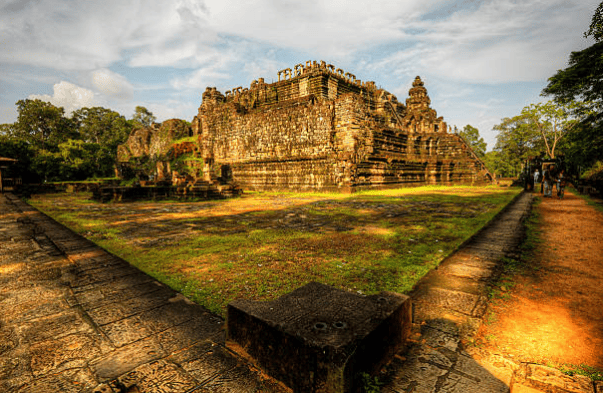
Built in the 12th century, Ta Prohm was originally a monastery and a learning center for monks. Historical records state that it once housed 18 High Priests, 650 dancers, and 12,500 residents. However, it was abandoned in the 17th century following the fall of the Khmer Empire. Rediscovered later, the temple underwent restoration, with efforts inspired by the restoration of Borobudur Temple.
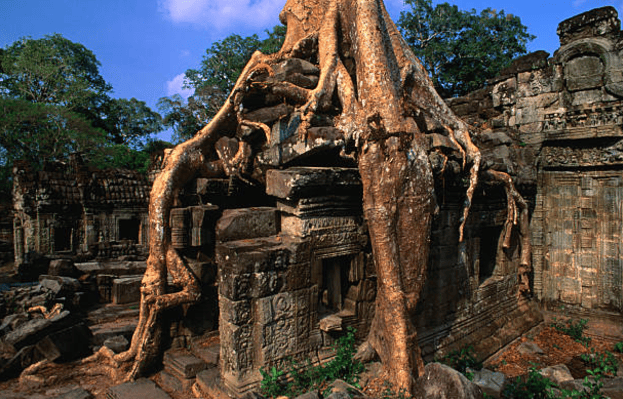
Today, Ta Prohm is the second-most visited temple in Angkor. The crowds make it challenging to take photos without other people in the frame. Many tourists flock to spots featured in Tomb Raider, and specific areas are designated for photos, requiring visitors to take turns. So, if you visit Angkor, be prepared to snap some memorable pictures!
Siem Reap City Center
Beyond Angkor, Siem Reap offers other attractions. At night, you can relax and enjoy Pub Street, bustling with restaurants, cafes, and pubs perfect for hanging out. Tourists gather here to soak up the lively evening atmosphere. It’s located just behind the Old Market of Siem Reap.
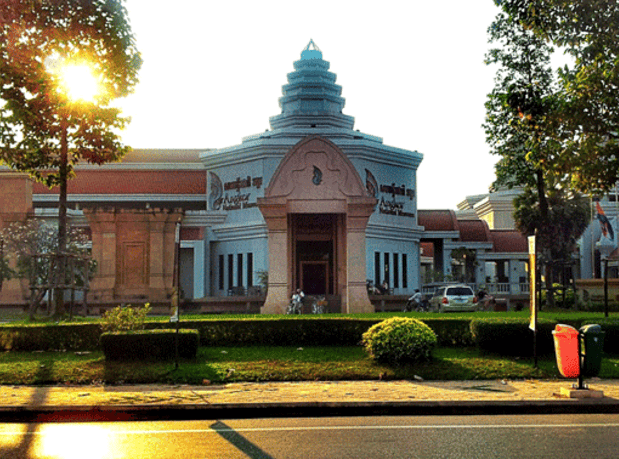
If you prefer quieter activities, visit the Angkor Night Market or the Old Market during the day. These markets open from morning until evening and are clean and easy to navigate. Here, you can shop for souvenirs, traditional fabrics, and Cambodian handicrafts.
For a deeper dive into history, head to the Angkor National Museum, conveniently located on the main road connecting Angkor and Siem Reap’s market area. Admission is $12 USD, and the museum features seven galleries detailing the history of the Khmer Empire.
